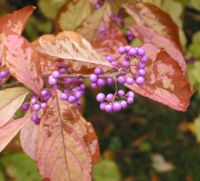Japanese beautyberry - Callicarpa japonica
English name:
Japanese beautyberry
Scientific name:
Callicarpa japonica
Family:
Verbenaceae (verbena or vervain)
Height:
2 M
Flowering:
first half of August
Range:
China, Korea, Japan
 |
|
 |
 |
The Callicarpa japonica in the upper picture is from seed collected by the Nordic Arboretum Committee expedition to South Korea in 1976. The seed was collected in Gangwon Province. This group of plants can be found behind the yellow brick office-building in square 1016 positions 2726 to 2927. A map with squares and positions can be found on our homepage under: Digital plant search of the Arboretum.
Plant description:
The genus Callicarpa has its centre of distribution in tropical and subtropical areas excluding those in Africa and South America. The genus has 140 species. The most northerly is Callicarpa japonica. We have 3 species of Callicarpa growing at Hørsholm (C. dichotoma, C. japonica, & C. mollis) or only about 2% of the total number of known species. The Arboretum has 19 specimens of Callicarpa japonica including representatives of 5 different wild-grown provenances from Japan and, Korea. Of these 2 came from the Nordic Arboretum committee expeditions to Japan and Korea in 1976.
Callicarpa japonica was introduced into western cultivation about 1845. The earliest reference I have found for cultivation in Denmark is from 1916. This species was first introduced into the Arboretum in 1951 and this original introduction is still alive.
Callicarpa japonica is mostly used as a garden plant for the outstanding autumn colour of its berries. In villages in Japan the plant is also praised for its strong stems, which are used for chopsticks and handles for implements.
These are deciduous shrubs up to 2 m high. The bark is grey-brown and nearly smooth with circular lenticels. Young shoots have minute star-shaped hairs. The winter buds are naked (without bud scales), short-stalked and covered with greyish, star-shaped hairs. Leaves are 3 to 15 cm long and occur opposite to each other on the shoots. They have a wedge shaped base and an obtuse tip at the apex. The margins are toothed or except near the base. The leaf petiole is short, 2-7 mm long and widely furrowed above. In the autumn the leaves are yellow to violet in colour. The flowers are numerous in the leaf axels with a 4 mm long tubular, 4 lobed, corolla. Stamens are 4 and exerted. The fruits are berry like drupes, 3-4 mm across, ripening to a striking violet colour in autumn. They are rounded, with a persistent calyx at the base and with 4 seeds.
Callicarpa jaoponica forms a moderately sized bush that is easily passed by until autumn when a spectacular show of small purple fruits develops. Their colour and glossiness makes them look artificial. Fruit develops on new shoots and some prune their plants quite strongly, but this does not appear to be necessary based on plants in our collection. Fruit development is increased when several plants are grown together for cross pollination. Often the leaves are of striking colours but the fruit is persistent and lasts well after the leaves are gone. There are no serious diseases, and it is easy to transplant. The Japanese beautyberry is described in the book Plants that merit attention- Bushes. It is a plant that definitely could be used more for autumn landscapes. The arboretum in Hørsholm has sent living specimens for trial at a number of other parks and gardens including: Vilvorde garden school, Sorø Akademy Garden, The Geographic Garden in Kolding, Århus Botanic Garden and Copenhagen Botanic Garden.
References:
Bean, W.J. 1980 Trees and Shrubs Hardy in the British Isles Vol IV A-C Eight edition. John Murray publishers. 808 pp.
Kurata, Satoru. 1976. Illustrated Important Forest Trees of Japan Vol 5. Chikyusha Co. Ltd. Tokyo. 238 pp.
Lange, J. 1999. Kulturplanternes Indførselshistorie i Danmark indtil midten af 1900-talet. (Introduction History of Cultivated Plants in Denmark up to the middle of the 20th century). DSR Forlag, Frederiksberg C. 458 pp.
Mabberley, D.J. 1998. The Plant Book. The Bath Press, Bath, 858 pp.
Olsen, O. et al. 1997 Havens Planteleksikon. Træer og Buske. (Danish Plant Encyclopedia, Trees & Bushes). Det Danske Haveselskab Publisher, 674 pp.
Petersen, O.G. 1916. Træer og Buske. Diagnoser til Dansk frilands-trævækst. (Trees and Bushes, Diagnosis for woody-plants outdoors in Denmark.) Gyldendalske Boghandel, Kjøbenhavn. 517 pp.
Brewster, N.P. 1996. Plants that merit attention. I. II Shrubs. Timber Press Inc. Portland.
Plants for a Future homepage:
http://pfaf.org/user/Plant.aspx?LatinName=Callicarpa+japonica
